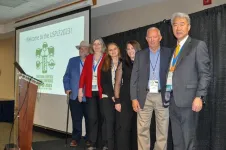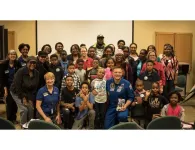(Press-News.org)
· Many racial and ethnic groups not well aware of food allergies
· Lack of food allergy research in racial and ethnic communities
· ‘These individuals need to be aware so they can be diagnosed and treated’
CHICAGO --- Food allergy has not been on the radar of most racial and ethnic communities. But a new Northwestern Medicine study — the first population-based food allergy study in the U.S. to explore racial and ethnic differences in all age groups — shows why it should be.
The new study found the prevalence of food allergy is highest among Hispanic, non-Hispanic Black and Asian individuals across all ages. And food allergy is lowest among households earning more than $150,000 a year.
The study will be published June 14 in JAMA Open Network.
There has been a paucity of population-based data of food allergy among racial and ethnic groups in the U.S., the authors said. Most previous studies also focused on children.
“Food allergies are not frequently talked about impacting racial and ethnic communities,” said study corresponding author Dr. Ruchi Gupta. “It’s not on the radar. But we now know it does impact them more, and it’s important to improve awareness.
“It is also critical to improve access to diagnosis and treatments for food allergy. It is an exciting time with new treatments, and making sure they reach racial and ethnic minorities who have higher rates of food allergy is essential.”
Gupta is director of the Center for Food Allergy and Asthma Research and a professor of pediatrics at Northwestern University Feinberg School of Medicine. She also is a physician at the Ann & Robert H. Lurie Children's Hospital of Chicago.
New treatments include various forms of immunotherapy including oral, epicutaneous (on the skin) and sublingual (under the tongue), all of which desensitize the immune system to the allergen. Another treatment is new biologics, Gupta said, which block the allergic reaction cascade.
When Gupta first began doing food-allergy research two decades ago, researchers did not know disparities existed.
“We now know that racial and ethnic minorities as well as underserved populations often do not get to an allergist for diagnosis," Gupta said. "They have the symptoms of food allergy but the access to get to a specialist has been challenging, and the fact that there were no treatments led them to just try and avoid the food.”
But the new study shows that food allergy — which affects 11% of adults and 8% of children in the U.S.— touches adults and children of every race and ethnicity.
Among the study findings:
Prevalence of food allergy is highest among Asian (10.5%), Hispanic (10.6%) and non-Hispanic Black individuals across all ages (10.6%).
Non-Hispanic Black individuals with food allergy were most likely to report food allergy to multiple foods (50.6%).
Asian and non-Hispanic white individuals had the lowest rates of severe food allergy reactions.
Prevalence of food allergy was lowest within households earning more than $150,000 per year (8.3%).
In addition to prevalence of food allergy, this study also reports on outcomes such as common food allergens, emergency department visits for food-allergic reactions and epinephrine usage. It also factors in socioeconomic status, which is related to food-allergy prevalence.
The study also suggests that an ensemble of allergic conditions all have similar patterns in terms of whom is affected. The ensemble is part of a progression of allergic conditions that develop over infancy and into childhood (called the atopic march) including eczema, food allergy, allergic rhinitis and asthma.
“There haven’t been enough genetic changes over the last 30 to 40 years to explain this grouping of allergic conditions,” said study co-author Christopher Warren, an epidemiologist and an assistant professor of preventive medicine at Northwestern University Feinberg School of Medicine. “Clearly, something has changed in the environment. It behooves us to figure out what are those changes, and how can we reverse them or add interventions to mitigate them.”
“It Is an exciting time in food allergy with new diagnostics, prevention and treatments,” Gupta said. “Our goal is to see these numbers start to come down in the next 30 to 40 years.”
In the study, a population-based survey was administered online and via telephone to a nationally representative sample of the U.S. population. More than 50,000 households were surveyed, comprising responses for nearly 80,000 individuals.
Northwestern is hosting a Global Food Allergy Prevention Summit July 7-9 in Chicago. Some of the sessions will cover food allergy disparities.
Other Northwestern authors include first author Jialing Jiang and Dr. Audrey Brewer.
The study was funded in part by grant R21AI135702 from National Institute of Allergy and Infectious Disease of the National Institutes of Health.
END
Ants navigate their richly aromatic world using an array of odor receptors and chemical signals called pheromones. Whether foraging or defending the nest, mating or tending to their young, ants both send and receive chemical signals throughout their lives. The importance of this system is underscored by how well equipped the ant brain is to process the abundance of scents: The olfactory processing center in the ant’s brain has 10 times as many subdivisions as fruit flies do, for example, even though their brains are about the same size.
And yet how the ant olfactory system encodes scent data has remained largely unknown. To whittle ...
AMHERST, Mass. – A team of physicists, including University of Massachusetts assistant professor Tigran Sedrakyan, recently announced in the journal Nature that they have discovered a new phase of matter. Called the “chiral bose-liquid state,” the discovery opens a new path in the age-old effort to understand the nature of the physical world.
Under everyday conditions, matter can be a solid, liquid or gas. But once you venture beyond the everyday—into temperatures approaching absolute zero, things smaller than a fraction ...
Researchers from the UvA Institute of Physics and ENS de Lyon have discovered how to design materials that necessarily have a point or line where the material doesn’t deform under stress, and that even remember how they have been poked or squeezed in the past. These results could be used in robotics and mechanical computers, while similar design principles could be used in quantum computers.
The outcome is a breakthrough in the field of metamaterials: designer materials whose responses are determined by their structure rather than their chemical composition. To construct a metamaterial with mechanical memory, physicists ...
When we walk around in our everyday life, we might not think of the Earth itself very often. But this planet is the foundation of our life. The air we breathe, the water we drink and the gravity that pins us to the ground.
Up until now, researchers believed that it took more than 100 million years for the Earth to form. And it was also common belief that water was delivered by lucky collisions with water-rich asteroids like comets.
However, a new study from the University of Copenhagen suggests that it might not have happened entirely by chance.
“We show that the Earth formed by the very ...
An international team led by Stefan Pelletier, a Ph.D. student at Université de Montréal's Trottier Institute for Research on Exoplanets announced today having made a detailed study of the extremely hot giant exoplanet WASP-76 b.
Using the MAROON-X instrument on the Gemini-North Telescope, the team was able to identify and measure the abundance of 11 chemical elements in the atmosphere of the planet.
Those include rock-forming elements whose abundances are not even known for giant planets in the Solar System such as Jupiter or Saturn. The team's study is published in ...
Some of the world’s best minds that are focused on profitable and sustainable livestock production attended and presented at the recent Second U.S. Precision Livestock Farming Conference. Hosted by University of Tennessee AgResearch, the May 21-24 event at the UT Conference Center in Knoxville attracted 219 attendees representing 22 countries and 32 U.S. states. Participants included academics, representatives of government agencies and allied industries as well as producers. The conference had a central theme of “Field Application of PLF Technologies” and academic presentations along with two industry and producer panels included interactive dialogues among the attendees ...
The results of a yearlong science program show that one of the best ways to instill a lasting interest in science among children is to engage them alongside their family members. This finding runs counter to the current framework, in which children attend science-related summer camps and after-school programs apart from their families, diminishing the long-term potential of what they learn.
“We wanted to see if we could support families as a whole, as opposed to giving a student a really amazing one-off experience and sending them ...
INDIANAPOLIS — In one of the first studies to investigate racial disparities in the pharmacologic treatment of insomnia, researchers from Regenstrief Institute and Indiana University report that patients belonging to racial minority groups were significantly less likely to be prescribed medication following diagnosis of insomnia than White patients.
The study found that Black patients were much less likely to have been prescribed an FDA-approved insomnia medication at any time post diagnosis than White patients. Other non-White individuals were significantly less likely to be prescribed an FDA-approved medication two, three, and four years after insomnia diagnosis ...
New York, NY, June 14, 2023 — The New York Academy of Sciences and the Leon Levy Foundation announced today the first cohort of Leon Levy Scholars in Neuroscience; a continuation of an earlier fellowship program started by the Foundation in 2009 that has supported 160 fellows in neuroscience.
This highly regarded postdoctoral program supports exceptional young researchers across the five boroughs of New York City as they pursue innovative investigations in neuroscience and advance in their careers toward becoming independent principal investigators. Designed to broaden the field and to support researchers who might otherwise not ...
June 14, 2023, TORONTO — Funding announced today by the Ontario Institute for Cancer Research (OICR) will help six Ontario-based research teams pursue their ultimate goal of improving the lives of people with cancer.
Funding comes through OICR’s Innovation to Implementation (I2I) program, which aims to help ensure new discoveries about preventing, diagnosing and treating cancer are adopted into healthcare policy and clinical practice.
“Every cancer researcher wants their work to have ...





